Beyond Sustainability (Opening Essay: October 2014 Special Issue of the eJournal of Public Affairs)
Patrick Ashton and Matthew Kubik
Indiana University
Purdue University Fort Wayne
Author Note
Patrick Ashton, Department of Sociology, Indiana University Purdue University Fort Wayne. Matthew Kubik, Department of Manufacturing & Construction Engineering Technology, Computer Science, Indiana University Purdue University Fort Wayne.
Correspondence concerning this article should be addressed to Dr. Patrick Ashton, Associate Professor Emeritus, Department of Sociology, Indiana University Purdue University Fort Wayne, 2101 E Coliseum Blvd, Fort Wayne, IN 46805-1499. E-mail: ashton@ipfw.edu.
Introduction
In 1987 the World Commission on Environment and Development—known as the Brundtland Commission—presented a new idea, sustainable development. The Commission’s report defined this new concept as “development which meets the needs of current generations without compromising the ability of future generations to meet their own needs” (WCED 1987: 43). The implications of this definition were immediately obvious. Not only was it a call to reshape current public policy to live within sustainable carrying capacity, but it also highlighted the need to focus on the welfare of future generations.
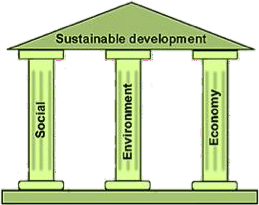
This definition of sustainable development was quickly elaborated. It was seen as consisting of three “pillars:” society, the environment, and the economy, as illustrated here. Emphasizing the underlying assumption of continued development of the built environment, the model took on the symbolic vestige of a temple pediment supported by columns or pillars. The first pillar focused on the welfare of people in terms of standard of living and quality of life. The second pillar focused on the welfare of the planet in terms of renewable resources and protection of the biosphere. The final pillar focused on the welfare of business in terms of profitability– specifically, how could sustainable development be incentivized so that businesses could make money by engaging in sustainable practices and providing sustainable products to consumers.
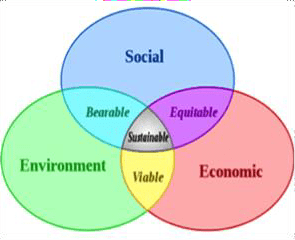
While this metaphor was useful in showing the importance of each pillar in contributing to overall sustainable development, it failed to recognize the interconnected and interdependent nature of each of the three areas. Thus a new model was developed: a Venn diagram of three overlapping circles. This model had the virtue of showing that sustainability was a dynamic product of the juncture of social needs and priorities with equitable business practices and the carrying capacity of the planet. There was a recognition that social equity and community are necessary for people to realize their individual and collective potential. Economic development is necessary, particularly for people with a low standard of living. At the same time sustainable development must preserve and protect the natural resource base and the environment. Economic and social well-being cannot be improved with measures that destroy the environment.
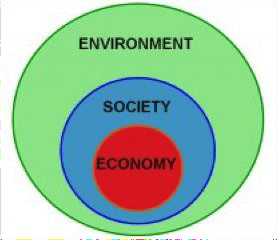
Though this second model advanced thinking about sustainability, critics pointed out that it retained a fundamental flaw of the pillar/temple metaphor: it incorrectly led us to think of the three factors as coequal and relatively independent of one another. In fact, they noted, the environment must be the overarching, all-encompassing concept. All human activity – economic and social – takes place on Planet Earth. And this planet, a blue marble floating through space, contains all the resources we will ever have. Moreover, the economy is not an independent entity, but rather functions within a sociopolitical context created by society, using resources available from within this specific planetary environment. This new thinking led to the development of a Nested Dependencies Model, illustrated here.
In this special issue of the eJournal of Public Affairs we contend that there is a flaw in these models and perhaps in the basic concept of sustainable development. Use of the term development implies a continued use and perhaps abuse of the limited planetary resources without consideration of the considerable environmental, social, and even economic havoc caused by current sedimented organizational structures and practices. What then is Beyond Sustainability?
We present to you articles and resources that assist in thinking about this issue. First, Molly Kerby and Gayle Mallinger, in their article “Beyond Sustainability: A New Conceptual Model,” argue for the necessity of developing an empirically testable multi-dimensional model of sustainability grounded in sound theoretical concepts. They briefly lay out the familiar history of the development of the concept of sustainability, pointing out that the pillars model tends to create intellectual silos while the overlapping circles model fails to recognize the fluid boundaries and complex interactions among the three circles. In their view, even the nested dependencies model, because it retains the concentric circles approach, unduly focuses on balance among the factors and homeostasis. The authors bring together theoretical ideas from child development and ecological theory to develop a model of sustainability based on the concepts of risk and resilience. Using systems thinking, they develop an empirically testable path model. While of course there will be arguments about the order, weighting, and relationships of the variables, Kerby and Mallinger have done a valuable service by starting the conversation in this area.
Next, Bo Su, in his article “Traditional Feng Shui Architecture as an Inspiration for the Development of Green Buildings,” chooses to look backward in order to take us forward. He reviews the ancient Chinese concept of Feng Shui. The ancient literature, he says, tells us that the point of using Feng Shui in the built environment was to capture energy by balancing the yin and yang of the mausoleum and the residence – in effect, between the ancestors and those living. At once there is a recognition here not only of the harmony and balance of nature, but of the interdependence of present and future generations. Bo Su argues that this is a needed form of systems thinking, echoing the call of Kerby and Mallinger, despite the radically different cultural origins of the ideas. This ancient idea of harmony between humans and nature could be key in developing a modern green architecture, Bo Su states, and then uses examples from the past to the present to show the application of these principles in many different environments.
D. Alexander Wait takes a look at how we might move Beyond Sustainability by linking sustainable practices to an institution’s mission statement. In his article, “Can a University’s Public Affairs Mission Move the Institution Beyond Sustainability?” Wait recognizes that, while institutional commitments to sustainability will vary and take different forms, a university with an existing commitment to public affairs ought to be particularly well-placed to also take on a commitment to sustainability. His article reports a case study in which he examines three measures of sustainability: institutional steps to acknowledge and incorporate sustainability, existing curriculum incorporating sustainability, and a survey of student interest and attitudes on the subject. While he finds that public affairs and sustainability are not linked at the curricular level, Wait argues that his case study illustrates that administrative initiatives and student attitudes that show that a public affairs mission can move an institution beyond sustainability.
The final article, by Diego Masi, is a chapter from his 2010 book Go Green: Il nuovo trend della comunicazione, which we have translated into English here for the first time. We have included it because we think that it is highly relevant, timely, provides a needed international perspective on public affairs and sustainability, and deserves a wider audience. First of all, Masi brings to his discussion of ongoing economic changes and needed policy changes a multifaceted background. He is an entrepreneur, communication professional and, perhaps most significantly, was twice elected as a member of the Italian parliament, where he served on the Labor Committee and was appointed Undersecretary of the Interior. So he has a track record of engagement with the practical politics of policymaking to promote sustainability. Perhaps surprisingly, the reader will discover that much of this chapter is about developments in the United States, though they are distinctly filtered through the lens of a center-left Italian politician and entrepreneur. Masi’s critique of the role of Big Oil and Big Banks is perhaps what you would expect from a left-leaning politician, but it is also exactly what we are hearing today from the Occupy movement and homegrown critics like Robert Reich. Writing at the beginning of the Obama administration, Masi examines the new president’s green agenda, arguing that leadership on the federal level is crucial. Masi expects real, sustainable change, however, to come from the grassroots. As an example, he points to extensive sustainable practices recently implemented in Chicago. This is accompanied by an extensive list of policy prescriptions. Masi concludes by comparing these progressive changes to the stagnating state of Italy in 2010, where it largely remains to this day.
So, what have we learned? Since the time of the Brundtland Commission report the Models for sustainability have continued to evolve. As a new concept each sustainability model strives to address the complex interrelationships between human need and environmental necessity. At the core of sustainability is the common understanding that the earth is a finite system and that humans are using resources at a faster rate than they can be regenerated. This was pointed out by economist Nicolas Georgescu-Roegen (1980) who warned that, “because the entropic abundance of the last two hundred years or so is rapidly approaching its end, we must reassess our approach to economic, political, and social evolution” (p. 268).
The primary definition of sustainability as sustainable development may be part of the problem. The term development is antithetical to the requirements of sustainability and itself signals reliance on concepts that are rooted in a worldview of continuous development that could be termed Plantation thinking (National Park Service, 1993). Characteristics of the traditional plantation include:
- a strong hierarchical organization
- exploitation/importation of energy such as by slavery
- environmental degradation through the removal of native plant material and the introduction of cash crops with an emphasis on profit rather than the environment
- importation and exportation as primary operational mode, including exportation of capital
- to some extent, importation of building forms and technologies
In our previous work we have established the countering principles of sustainability. In concert with academics and practitioners from around the world we developed a document called The Berlin Manifesto (Ashton and Kubik 2009) which delineated the necessity to:
- develop an ethic of being in the world instead of domination over the world.
- recognize that we are part of natural systems.
- integrate into natural processes.
- respect the diversity and complexity of natural systems.
- emulate the cyclical flow of natural systems, in which surplus is returned to the nutrient pool.
- achieve a balance of resource use with the ability of systems to regenerate.
- rely on natural energy flows following the physics principle of least action.
- minimize entropy.
- strive for social equity.
These principles provide a map for social, cultural and economic change based on an understanding that unbounded and expanding use of planetary resources have degraded the environment to the detriment of all humans. Rejecting the concept of sustainable development, the term sustainable implies establishing a baseline status quo.
This is not enough. We cannot merely sustain. The magnitude of destruction and depletion of resources including social capital is such that we must move beyond sustainability to restore, reconnect, and regenerate. In our book The Green Age (Leffers et al., 2011) we provide a new definition for progress: “we would feel we were making progress if the actions we take serve to ensure that the Earth is able to sustain itself and its inhabitants—thatis, what we do nourishes it so well that it is able to provide nourishment for current and future inhabitants.” We propose here that we move Beyond Sustainability to Regeneration. In both biology and social science, regeneration is a process of healing. As a response to pathology, healing promotes growth that restores and revitalizes an individual or a system.
We propose a model of Regeneration that we call Aesculapia based on the Greek place of healing. In this model the restorative qualities of nature are respected and nurtured. Harmony is established between the human experience and the environment. In Aesculapia regenerative action allows a reconnection of human needs to the natural systems upon which all life is based.
Returning to previous models of sustainability, we agree with the critique of authors Kerby and Mallinger and Wait in this issue of the eJournal that a limitation of the overlapping circles model is that elements are seen as independent. Moving beyond sustainability we must look both backward and forward— backward to a complex remembered past embracing timeless principles that propel us to a sustainable future as suggested by Bo Su. Finally, we must meet the social and economic challenges outlined by Masi.
Our model, we would argue, overcomes the limitations of the static, two- dimensional nested dependencies model by allowing us to demonstrate in three dimensions a complex, dynamic interrelationship among the elements. A primary flaw of the previous models is the equal weight given to the Economy as if this was an autonomous independent force acting on the society and the environment. The Kubik/Ashton Aesculapia model proposes that the Economy is not an independent force, but rather governed by the politics and culture of the society in which it is located. In addition, it is a mediating element, channeling resources of the natural environment for the use of Society. It is the needs and demands of society, both necessary and profligate, which determine the magnitude of the economic channel, and the political and cultural organization which determines its form. Nonetheless, Economy is subject to the actions of Society to the benefit or detriment of the Environment. This is why it is a smaller sphere in the middle of the model.
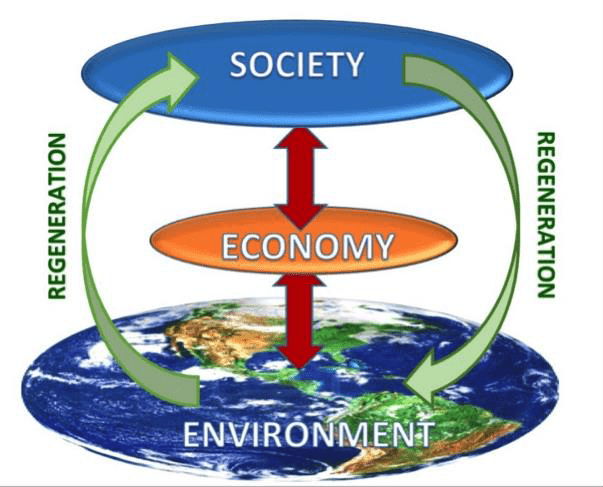
Society embraces the Economy, yet is located within the boundaries of our finite Environment. Our concept of society includes culture, which, in the evolving definition, has been designated a fourth pillar. A fundamental insight of sociology, anthropology and other social sciences, however, is that culture and society are part of the same fabric and cannot be separated.
If progress is nourishing, then actions taken must serve to ensure that the Earth is able to sustain itself and its inhabitants. Regeneration requires decisions made in society to heal the planet, not just sustain it. In return the planet heals us – establishing Aesculapia. Thus the dual feedback mechanisms between Society and the Environment. This dynamic model has the potential to inform both grassroots activism and public policy decisions to truly move us Beyond Sustainability in the realm of public affairs.
References
Adams, W.M. (2006). The Future of Sustainability: Re-thinking Environment and Development in the Twenty-first Century. Report of the IUCN Renowned Thinkers Meeting, 29–31 January 2006. Gland, Switzerland: International Union for Conservation of Nature.
Ashton, P.J. & Kubik, M. (2009). The Berlin Manifesto: Social transformation for sustainable design. Design Principles and Practices: An International Journal, 3(6), 281-290.
Georgescu-Roegen, N. (1980). Afterword. In Jeremy Rifkin, Entropy (pp. 261- 269). New York, NY: Bantam Books.
Leffers, M. R., Kubik, M. & Ashton, P.J. (2011). The Green Age: Transforming your life choices for the 21st Century, Fort Wayne, IN: Green Age Press. National Park Service (1993). Guiding principles of sustainable design. Denver, CO: U.S. Department of the Interior, National Park Service, Denver Service Center.
Scott Cato, M. (2009). Green Economics. London: Earthscan,
WCED (World Commission on Environment and Development) (1987). Our Common Future. New York: Oxford University Press, 1987.
Author Biographies
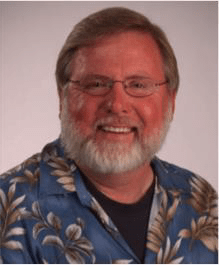
Patrick J. Ashton, Ph.D., teaches sociology and conflict resolution. He has been researching and writing about the interface between human community and the built environment for over 30 years. His publications include development of a paradigm for sustainability in the built environment, analyses of the political economy of suburban development, the impact of a large-scale plant closing on urban community, and the characteristics and dynamics of community organization. With Regina Leffers and Matthew Kubik, Pat recently co-authored the book The Green Age: Transforming Your Life for the 21st Century. Pat and Matt Kubik are founders and partners in the consulting firm Create the Green Age, focused on developing and facilitating democratic design dialogues around sustainability and regeneration of the built environment. Over the past several years they have been conducting sustainable design workshops in Europe and the United States.
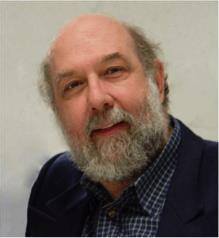
Matthew Kubik, Architect, teaches courses in architecture, urban form, and sustainability. In 1975 he graduated from the Architectural Association School of Architecture, London, England with a masters level Graduate Diploma earned for his urban and architecture energy conservation research. He is the winner of two awards for Excellence in Architecture granted by the American Institute of Architects. As a popular invited speaker he has given lectures nationally on sustainability in interior design, architecture and urban planning. With his colleague Patrick Ashton he presented a national live teleconference broadcast to over 60 university campuses. In 2005, Matt served as History Channel script consultant and was interviewed for the television program, Life After People-the Series. Since the 1970’s he has been designing projects with minimum environmental impact as a design determinant. His portfolio includes earth sheltered housing, appropriate technology detailing, closed loop environmental systems, and passive solar architecture.